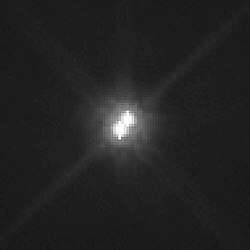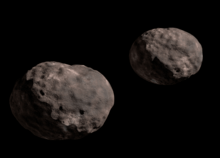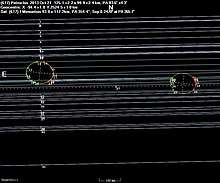617 Patroclus
617 Patroclus /pəˈtroʊkləs/ is a binary Jupiter trojan approximately 140 kilometers (87 miles) in diameter.[lower-alpha 1] It was discovered on 17 October 1906, by astronomer August Kopff at the Heidelberg Observatory in Germany. The asteroid was named after Patroclus from Greek mythology.[1] It was the second trojan to be discovered and the only member of the Trojan camp named after a Greek character.[3] The dark D-type asteroid is also slow rotator and one of the largest Jupiter trojans. Patroclus is one of five Jovian asteroids targeted by the Lucy space probe to be visited in 2033. In 2001, a moon – later named Menoetius, and slightly smaller than its primary – was discovered. It was the first discovery of a binary asteroid among the Jupiter trojans.[9]
 Hubble Space Telescope image composite of Patroclus and its companion Menoetius, taken in 2018 | |
| Discovery [1] | |
|---|---|
| Discovered by | A. Kopff |
| Discovery site | Heidelberg Obs. |
| Discovery date | 17 October 1906 |
| Designations | |
| (617) Patroclus | |
| Pronunciation | /pəˈtroʊkləs/[2] |
Named after | Πάτροκλος Patroklos (Greek mythology)[3] |
| 1906 VY · 1941 XC 1962 NB | |
| Jupiter trojan [1][4][5] Trojan [6][7] · background [7] | |
| Adjectives | Patroclean /pætrəˈkliːən/[8] |
| Orbital characteristics [4] | |
| Epoch 23 March 2018 (JD 2458200.5) | |
| Uncertainty parameter 0 | |
| Observation arc | 19.15 yr (6,993 d) |
| Aphelion | 5.9376 AU |
| Perihelion | 4.4959 AU |
| 5.2167 AU | |
| Eccentricity | 0.1382 |
| 11.92 yr (4,352 d) | |
| 170.39° | |
| 0° 4m 57.72s / day | |
| Inclination | 22.047° |
| 44.354° | |
| 308.15° | |
| Known satellites | 1 (Menoetius)[9] |
| Jupiter MOID | 0.1966 AU |
| TJupiter | 2.8360 |
| Physical characteristics | |
| Dimensions | 127 km × 117 km × 98 km (primary only)[10] |
Mean diameter | 113±3 km (primary only)[10] 140.36±0.87 km[11] 140.85±3.37 km[12] 140.92±4.7 km[13] 143.14±8.37 km[14] 154 km[10] |
| Volume | 1.36×106 km3[10] |
| Mass | (1.36±0.11)×1018 kg[14] 1.20×1018 kg[10] |
Mean density | 0.88±0.17 g/cm3[14][10] |
| 40 h (at least; dated)[15] 102.8 h[16] 102 h[17] 103.02±0.40 h[18] 103.5±0.3 h[19] | |
| 0.047±0.003[11][12][13] | |
| D (Tholen)[20] C0 (Barucci)[20] D (Tedesco)[20] U–B = 0.215±0.045[20] B–V = 0.710±0.050[21] V–R = 0.420±0.030[21] V–I = 0.830±0.020[21] | |
| 8.19[4][11][12][13][5] | |
Orbit
Patroclus orbits in Jupiter's trailing Lagrangian point, L5,[9] in an area called the Trojan camp after one of the sides in the legendary Trojan War (the other node, at the L4 point, is called the "Greek camp").
It orbits the Sun at a distance of 4.5–5.9 AU once every 11 years and 11 months (4,353 days). Its orbit has an eccentricity of 0.14 and an inclination of 22° with respect to the ecliptic.[4] The asteroid's observation arc begins at the discovering Heidelberg Observatory in November 1906, about 3 weeks after its official discovery observation.[1]
Binary system


 Plot of the results of the multi-chord stellar occultation by 617 Patroclus and Menoetius | |
| Discovery | |
|---|---|
| Discovery date | 2001 |
| Designations | |
| Pronunciation | /mɪˈniːʃəs/ mi-NEE-shəs |
Named after | Menoetius (Greek mythology) |
| Adjectives | Menoetian /mɪˈniːʃən/[22]) |
| Orbital characteristics | |
| 680±20 km[9] 664.6 km[10] | |
| 102.8 h | |
| Satellite of | Patroclus |
| Physical characteristics | |
| Dimensions | 117 km × 108 km × 90 km[10] |
Mean diameter | 104±3 km[10] |
In 2001, it was discovered that Patroclus is a binary system, made up of two components with of roughly similar size.[9][23][24] It is one of 18 binary Trojan asteroids known to exist. In 2006, accurate measurements of the orbit from the Keck Laser guide star adaptive optics system were reported.[25]
It was estimated[26] that the two components orbit around their center of mass in 4.283±0.004 days at a distance of 680±20 km in a roughly circular orbit.[9] Combining these observations with thermal measurements taken in 2000, the sizes of the components of the system were estimated at 106 km and 98 km, with an equivalent whole-system diameter of 145 km,[9] refined by later measurements from the Keck Observatory to approximately 122 km and 112 km for each partner,[27] and a co-orbital period of 103.5±0.3 hours (4.3125±0.0125 days).[25][19]
On 21 October 2013, both bodies occulted a magnitude 8.8 star as observed by a team of 41 observers stationed across the USA. Observation data put the orbital distance of 664.6 km, and give a size for the slightly larger component, which retains the name Patroclus with overall volume equivalent to a 113 km sphere, with the smaller component now named Menoetius with a volume equivalent to a 104 km diameter sphere.
Physical characteristics
Lightcurves
Since 1989, several rotational lightcurves of Patroclus have been obtained from photometric observations. Analysis of the best rated lightcurves gave a rotation period between 102.8 and 103.5 hours with a brightness amplitude of less than 0.1 magnitude (U=2/3/).[16][17][18][19] A low brightness variation typically indicates that a body has a nearly spheroidal shape. Its long rotation period makes it a slow rotator.
Diameter and albedo
According to the surveys carried out by the Infrared Astronomical Satellite IRAS and NASA's Wide-field Infrared Survey Explorer with its subsequent NEOWISE mission, the Patroclus system has an effective combined size between 140.36 and 140.92 kilometers in diameter and its surface has an albedo of 0.047.[11][13] The Collaborative Asteroid Lightcurve Link adopts the results obtained by IRAS, that is, an albedo of 0.0471 and a diameter of 140.92 kilometers based on an absolute magnitude of 8.19.[5]
| Trojan | Diameter (km) |
|---|---|
| 624 Hektor | 225 |
| 617 Patroclus | 140 |
| 911 Agamemnon | 131 |
| 588 Achilles | 130 |
| 3451 Mentor | 126 |
| 3317 Paris | 119 |
| 1867 Deiphobus | 118 |
| 1172 Äneas | 118 |
| 1437 Diomedes | 118 |
| 1143 Odysseus | 115 |
| Source: JPL Small-Body Database, NEOWISE data | |
Composition
Recent evidence suggests that the objects are icy like comets, rather than rocky like most asteroids. In the Tholen classification, Patroclus is a dark P-type asteroid.[5]
Because the density of the components (0.88 g/cm³) is less than water and about one third that of rock, it was suggested that the Patroclus system, previously thought to be a pair of rocky asteroids, is more similar to a comet in composition.[25] It is suspected that many Jupiter trojans are in fact small planetesimals captured in the Lagrange point of the Jupiter–Sun system during the migration of the giant planets 3.9 billion years ago. This scenario was proposed by A. Morbidelli and colleagues in a series of articles published in May 2005 in Nature.[28]
Exploration

Patroclus is a proposed target for Lucy, a mission to several asteroids, mostly Jupiter trojans.[29] The mission's targets with their flyby dates are:[30][31]
- 52246 Donaldjohanson — 20 April 2025: 4 km diameter C-type asteroid in the inner main-belt, member of the ~130Myr old Erigone family;
- 3548 Eurybates — 12 August 2027: 64 km diameter C-type Jupiter Trojan in the Greek camp at L4, largest member of the only confirmed disruptive collisional family in the Trojans;
- 15094 Polymele — 15 September 2027: 21 km diameter P-type Trojan at L4, likely collisional fragment;
- 11351 Leucus — 18 April 2028: 34 km diameter D-type slow rotator Trojan at L4;
- 21900 Orus — 11 November 2028: 51 km diameter D-type Trojan at L4;
- 617 Patroclus — 2 March 2033: P-type binary Trojan. The primary, Patroclus, has a mean diameter of 113 km and its companion, Menoetius, has a diameter of 104 km. The pair orbit at a separation of 680 km. The binary resides in the Trojan camp at L5.
Naming
This minor planet was named after the Greek hero Patroclus from Greek mythology. Friend of Achilles, he was killed by Hector during the Trojan War (see also (588) and (624)). The minor planet's name was proposed by Austrian astronomer Johann Palisa. The official naming citation was mentioned in The Names of the Minor Planets by Paul Herget in 1955 (H 65).[3]
Patroclus is the only object in the Trojan camp to be named after a Greek rather than a Trojan character. The naming conventions for the Jupiter trojans were not adopted until after Patroclus was named (similarly, the asteroid Hektor is the only Trojan character to appear in the Greek camp).
Notes
- Buie (2015). Volume equivalent diameters based on derived ellipsods are: Patroclus: 113 km and Menoetius: 104 km, while for the combined system, a mean-diameter of 154 km is given. Measured by asteroid occultation. Alternative observations gave a combined diameter of 140 kilometers. Summary figures for (617) Patroclus at the LCDB.
References
- "617 Patroclus (1906 VY)". Minor Planet Center. Retrieved 13 June 2018.
- "Patroclus". Dictionary.com Unabridged. Random House. Note that this irregular pronunciation was used by Pope for metrical convenience in verse, and has become established in English.
- Schmadel, Lutz D. (2007). "(617) Patroclus". Dictionary of Minor Planet Names – (617) Patroclus. Springer Berlin Heidelberg. p. 62. doi:10.1007/978-3-540-29925-7_618. ISBN 978-3-540-00238-3.
- "JPL Small-Body Database Browser: 617 Patroclus (1906 VY)" (2017-06-14 last obs.). Jet Propulsion Laboratory. Retrieved 13 June 2018.
- "LCDB Data for (617) Patroclus". Asteroid Lightcurve Database (LCDB). Retrieved 11 July 2017.
- "List of Jupiter Trojans". Minor Planet Center. 20 August 2016. Retrieved 11 July 2017.
- "Asteroid (617) Patroclus – Proper elements". AstDyS-2, Asteroids – Dynamic Site. Retrieved 13 June 2018.
- Riggs (1972) The Christian poet in Paradise lost
- Johnston, Wm. Robert (21 September 2014). "(617) Patroclus and Menoetius". johnstonsarchive.net. Retrieved 11 July 2017.
- Buie, Marc W.; Olkin, Catherine B.; Merline, William J.; Walsh, Kevin J.; Levison, Harold F.; Timerson, Brad; et al. (March 2015). "Size and Shape from Stellar Occultation Observations of the Double Jupiter Trojan Patroclus and Menoetius". The Astronomical Journal. 149 (3): 11. Bibcode:2015AJ....149..113B. doi:10.1088/0004-6256/149/3/113. Retrieved 11 July 2017.
- Grav, T.; Mainzer, A. K.; Bauer, J. M.; Masiero, J. R.; Nugent, C. R. (November 2012). "WISE/NEOWISE Observations of the Jovian Trojan Population: Taxonomy". The Astrophysical Journal. 759 (1): 10. arXiv:1209.1549. Bibcode:2012ApJ...759...49G. doi:10.1088/0004-637X/759/1/49. (online catalog)
- Usui, Fumihiko; Kuroda, Daisuke; Müller, Thomas G.; Hasegawa, Sunao; Ishiguro, Masateru; Ootsubo, Takafumi; et al. (October 2011). "Asteroid Catalog Using Akari: AKARI/IRC Mid-Infrared Asteroid Survey". Publications of the Astronomical Society of Japan. 63 (5): 1117–1138. Bibcode:2011PASJ...63.1117U. doi:10.1093/pasj/63.5.1117. Retrieved 13 June 2018. (online, AcuA catalog p. 153)
- Tedesco, E. F.; Noah, P. V.; Noah, M.; Price, S. D. (October 2004). "IRAS Minor Planet Survey V6.0". NASA Planetary Data System: IRAS-A-FPA-3-RDR-IMPS-V6.0. Bibcode:2004PDSS...12.....T. Retrieved 13 June 2018.
- Carry, B. (December 2012). "Density of asteroids". Planetary and Space Science. 73 (1): 98–118. arXiv:1203.4336. Bibcode:2012P&SS...73...98C. doi:10.1016/j.pss.2012.03.009. See Table 1.
- Gonano, M.; Mottola, S.; Neukum, G.; di Martino, M. (December 1990). "Physical study of outer belt asteroids". Space Dust and Debris; Proceedings of the Topical Meeting of the Interdisciplinary Scientific Commission B /Meetings B2. 11 (12): 197–200. Bibcode:1991AdSpR..11..197G. doi:10.1016/0273-1177(91)90563-Y. ISSN 0273-1177. Retrieved 11 July 2017.
- Marchis, Franck; Hestroffer, Daniel; Descamps, Pascal; Berthier, Jérô; me; Bouchez, Antonin H.; et al. (February 2006). "A low density of 0.8gcm-3 for the Trojan binary asteroid 617Patroclus". Nature. 439 (7076): 565–567. arXiv:astro-ph/0602033. Bibcode:2006Natur.439..565M. doi:10.1038/nature04350. PMID 16452974. Retrieved 11 July 2017.
- Behrend, Raoul. "Asteroids and comets rotation curves – (617) Patroclus". Geneva Observatory. Retrieved 11 July 2017.
- Mueller, Michael; Marchis, Franck; Emery, Joshua P.; Harris, Alan W.; Mottola, Stefano; Hestroffer, Daniel; et al. (February 2010). "Eclipsing binary Trojan asteroid Patroclus: Thermal inertia from Spitzer observations". Icarus. 205 (2): 505–515. arXiv:0908.4198. Bibcode:2010Icar..205..505M. doi:10.1016/j.icarus.2009.07.043.
- Oey, Julian (July 2012). "Period Determination of 617 Patroclus". The Minor Planet Bulletin. 39 (3): 106–107. Bibcode:2012MPBu...39..106O. ISSN 1052-8091. Retrieved 11 July 2017.
- "Asteroid 617 Patroclus". Small Bodies Data Ferret. Retrieved 13 June 2018.
- Chatelain, Joseph P.; Henry, Todd J.; French, Linda M.; Winters, Jennifer G.; Trilling, David E. (June 2016). "Photometric colors of the brightest members of the Jupiter L5 Trojan cloud". Icarus. 271: 158–169. Bibcode:2016Icar..271..158C. doi:10.1016/j.icarus.2016.01.026. Retrieved 12 June 2018.
- Redfield (1994) Nature and culture in the Iliad: the tragedy of Hector
- Merline, W. J. (2001), IAUC 7741: 2001fc; S/2001 (617) 1; C/2001 T1, C/2001 T2
- "Satellites and Companions of Minor Planets". IAU / CBAT. 17 September 2009. Archived from the original on 21 January 2011. Retrieved 25 January 2011.
- Marchis, F.; Hestroffer, D.; Descamps, P.; Berthier, J. R. M.; Bouchez, A. H.; Campbell, R. D.; Chin, J. C. Y.; Van Dam, M. A.; Hartman, S. K.; Johansson, E. M.; Lafon, R. E.; Le Mignant, D. L.; De Pater, I.; Stomski, P. J.; Summers, D. M.; Vachier, F. D. R.; Wizinovich, P. L.; Wong, M. H. (2 February 2006). "A low density of 0.8 g cm-3 for the Trojan binary asteroid 617 Patroclus". Nature. 439 (7076): 565–567. arXiv:astro-ph/0602033. Bibcode:2006Natur.439..565M. doi:10.1038/nature04350. PMID 16452974.
- Sanders, Robert (2006), Binary asteroid in Jupiter's orbit may be icy comet from solar system's infancy, University of California, Berkeley
- Sanders, Robert. "Trojan Binary Asteroid – Patroclus & Menoetius". UC Berkeley. Retrieved 4 October 2017.
- Morbidelli, A.; Levison, H. F.; Tsiganis, K.; Gomes, R. (26 May 2005). "Chaotic capture of Jupiter's Trojan asteroids in the early Solar System". Nature. 435 (7041): 462–465. Bibcode:2005Natur.435..462M. doi:10.1038/nature03540. PMID 15917801.
- Dreier, Casey; Lakdawalla, Emily (30 September 2015). "NASA announces five Discovery proposals selected for further study". The Planetary Society. Retrieved 1 October 2015.
- Levison, H. F.; Olkin, C.; Noll, K. S.; Marchi, S.; Lucy Team (March 2017). "Lucy: Surveying the Diversity of the Trojan Asteroids: The Fossils of Planet Formation" (PDF). 48th Lunar and Planetary Science Conference (1964): 2025. Bibcode:2017LPI....48.2025L. Retrieved 13 April 2017.
- https://www.hou.usra.edu/meetings/lpsc2017/pdf/2025.pdf
External links
- Keck Obs. press release Trojan Asteroid Patroclus: Comet in Disguise?
- Patroclus and Menoetius web page
- Asteroids with Satellites, Robert Johnston, johnstonsarchive.net
- Asteroid Lightcurve Database (LCDB), query form (info)
- Dictionary of Minor Planet Names, Google books
- Discovery Circumstances: Numbered Minor Planets (1)-(5000) – Minor Planet Center
- 617 Patroclus at AstDyS-2, Asteroids—Dynamic Site
- 617 Patroclus at the JPL Small-Body Database
